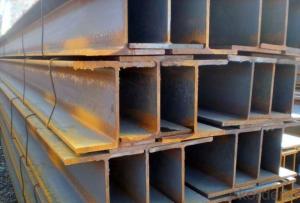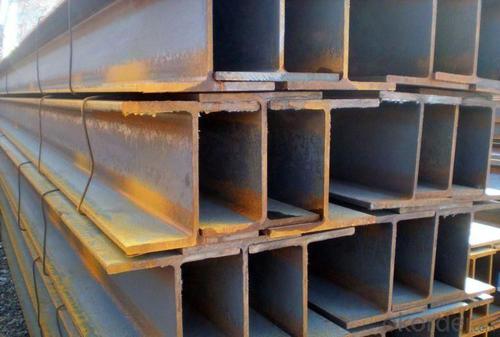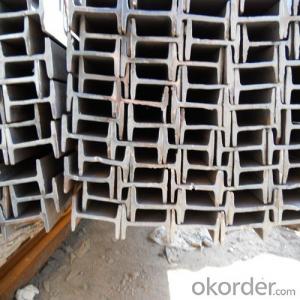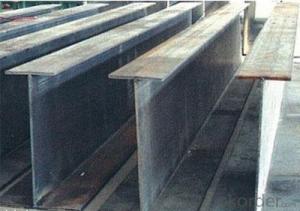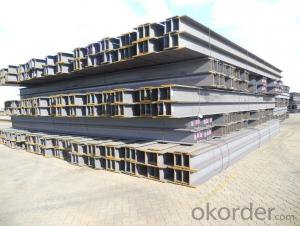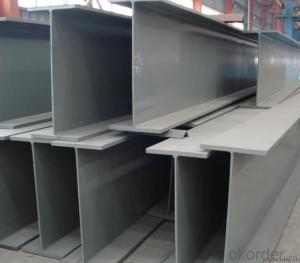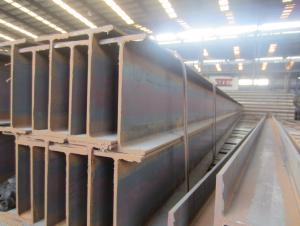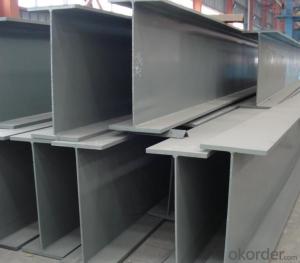carbon steel H BEAM for construction JIS G 3192
- Loading Port:
- Tianjin
- Payment Terms:
- TT or LC
- Min Order Qty:
- 25 m.t.
- Supply Capability:
- 100000 m.t./month
OKorder Service Pledge
OKorder Financial Service
You Might Also Like
Product Description:
OKorder is offering carbon steel H Beam for construction JIS G 3192 at great prices with worldwide shipping. Our supplier is a world-class manufacturer of steel, with our products utilized the world over. OKorder annually supplies products to European, North American and Asian markets. We provide quotations within 24 hours of receiving an inquiry and guarantee competitive prices.
Product Applications:
Carbon steel H Beam are ideal for structural applications and are widely used in the construction of buildings and bridges, and the manufacturing, petrochemical, and transportation industries.
Product Advantages:
OKorder's steel H Beam are durable, strong, and resist corrosion.
Main Product Features:
· Premium quality
· Prompt delivery & seaworthy packing (30 days after receiving deposit)
· Corrosion resistance
· Can be recycled and reused
· Mill test certification
· Professional Service
· Competitive pricing
Product Specifications:
1. Standard: JIS
2. Grade: SS400
3. Length: 12m
4. Invoicing on theoretical weight or actual weight as customer request
5.Payment: TT or L/C
6. Sizes:
H x B
(mm)
| T1 | T2 | JIS Weight
(kg/m)
| GB Weight
(kg/m)
|
100*100 | 6 | 8 | 16.9 | 17.2 |
125*125 | 6.5 | 9 | 23.6 | 23.8 |
150*75 | 5 | 7 | 14 | 14.3 |
148*100 | 6 | 9 | 20.7 | 21.4 |
150*150 | 7 | 10 | 31.1 | 31.9 |
175*90 | 5 | 8 | 18 | 18.2 |
175*175 | 7.5 | 11 | 40.4 | 40.4 |
198*99 | 4.5 | 7 | 17.8 | 18.5 |
200*100 | 5.5 | 8 | 20.9 | 21.7 |
194*150 | 6 | 9 | 29.9 | 31.2 |
200*200 | 8 | 12 | 49.9 | 50.5 |
248*124 | 5 | 8 | 25.1 | 25.8 |
250*125 | 6 | 9 | 29 | 29.7 |
244*175 | 7 | 11 | 43.6 | 44.1 |
250*250 | 9 | 14 | 71.8 | 72.4 |
298*149 | 5.5 | 8 | 32 | 32.6 |
298*201 | 9 | 14 | 65.4 | |
300*150 | 6.5 | 9 | 36.7 | 37.3 |
294*200 | 8 | 12 | 55.8 | 57.3 |
300*300 | 10 | 15 | 93 | 94.5 |
346*174 | 6 | 9 | 41.2 | 41.8 |
350*175 | 7 | 11 | 49.4 | 50 |
340*250 | 9 | 14 | 78.1 | 79.7 |
350*350 | 12 | 19 | 135 | 137 |
400*200 | 8 | 13 | 65.4 | 66 |
390*300 | 10 | 16 | 105 | 107 |
400*400 | 13 | 21 | 172 | 172 |
446*199 | 8 | 12 | 65.1 | 66.7 |
450*200 | 9 | 14 | 77.9 | 79.5 |
440*300 | 11 | 18 | 121 | 124 |
496*199 | 9 | 14 | 77.9 | 79.5 |
500*200 | 10 | 16 | 88.2 | 89.6 |
488*300 | 11 | 18 | 125 | 129 |
596*199 | 10 | 15 | 92.5 | 95.1 |
600*200 | 11 | 17 | 103.4 | 106 |
588*300 | 12 | 20 | 147 | 151 |
700*300 | 13 | 24 | 182 | 185 |
800*300 | 14 | 26 | 207 | 210 |
900*300 | 16 | 28 | 240.1 | 243 |
FAQ:
Q1: How do we guarantee the quality of our products?
A1: We have established an advanced quality management system which conducts strict quality tests at every step, from raw materials to the final product. At the same time, we provide extensive follow-up service assurances as required.
Q2: Can stainless steel rust?
A2: Stainless does not "rust" as you think of regular steel rusting with a red oxide on the surface that flakes off. If you see red rust it is probably due to some iron particles that have contaminated the surface of the stainless steel and it is these iron particles that are rusting. Look at the source of the rusting and see if you can remove it from the surface.
Images:
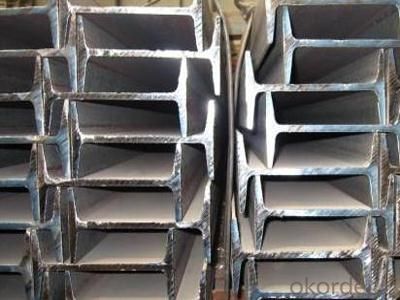
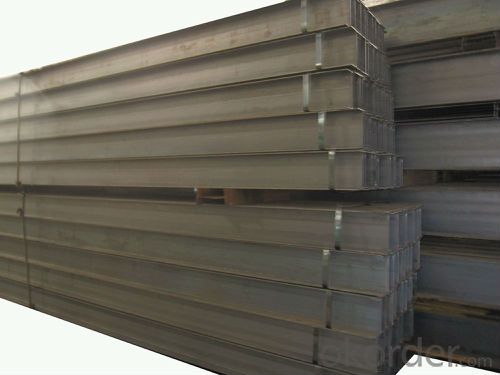

- Q: What are the different types of steel H-beam connections used in seismic design?
- Seismic design incorporates various types of steel H-beam connections to ensure structural stability and earthquake resistance. These connections facilitate the transfer of forces and loads between different structural members, such as beams and columns, while maintaining overall structural integrity. Some commonly used H-beam connections in seismic design include: 1. Welded Connections: These connections are widely utilized in seismic design due to their simplicity and effectiveness. Welding the H-beam flanges and web together creates a strong and rigid connection capable of withstanding axial and lateral forces, making it suitable for seismic applications. 2. Bolted Connections: This type of connection involves using high-strength bolts to join H-beam components. Bolted connections offer easy assembly and disassembly, which can be advantageous during construction or retrofitting. Proper bolt pre-tensioning is essential to ensure adequate strength and stiffness. 3. Extended End-Plate Connections: When greater resistance against lateral forces is required, extended end-plate connections are commonly used. In this connection type, the end-plate extends beyond the H-beam flanges and is bolted to the column or another beam. The extended end-plate provides additional rigidity and strength to withstand seismic forces. 4. Reduced Beam Section (RBS) Connections: RBS connections are specifically designed to dissipate earthquake energy and maintain overall structural integrity during seismic events. A portion of the H-beam flange is removed in this connection type, creating a weak section that yields and absorbs seismic forces, protecting the rest of the structure. RBS connections are frequently employed in moment-resisting frames to prevent brittle failures. 5. Seismic Shear Tabs: Seismic shear tabs are small steel plates welded to the H-beam flanges and connected to the supporting structure, such as columns or walls. These tabs enhance the shear capacity of the connection and aid in distributing lateral forces during earthquakes. Seismic shear tabs are often combined with other connection types to enhance the overall seismic performance of the structure. It is important to consider various factors, including the structural system, load requirements, and specific seismic design criteria, when selecting the appropriate H-beam connection type in seismic design. Structural engineers and designers carefully evaluate these factors to determine the most suitable connection type for each application, ensuring the safety and stability of the structure under seismic conditions.
- Q: Are steel H-beams suitable for modular construction?
- Yes, steel H-beams are suitable for modular construction. H-beams, also known as I-beams or W-beams, are widely used in the construction industry due to their high strength-to-weight ratio and versatility. They are especially suitable for modular construction, a process that involves fabricating building components off-site and assembling them at the construction site. Steel H-beams offer several advantages for modular construction. Firstly, their structural strength allows for the creation of large, open spaces without the need for excessive support columns or walls. This makes them ideal for constructing modular buildings that require flexibility in interior layout and design. Additionally, H-beams are lightweight compared to their load-bearing capacity, making them easier to transport and handle during the modular construction process. Their prefabricated nature also reduces the time and labor required on-site, resulting in faster construction timelines and cost savings. Furthermore, steel H-beams have excellent durability and resistance to environmental factors such as fire, corrosion, and pests. This ensures that modular buildings constructed using H-beams have a longer lifespan and require minimal maintenance. Lastly, steel H-beams can be easily recycled, making them a sustainable choice for modular construction. Their high scrap value and recyclability contribute to reducing the environmental impact of construction projects. In conclusion, steel H-beams are highly suitable for modular construction due to their structural strength, lightweight nature, durability, and sustainability. They allow for the creation of flexible and spacious modular buildings while reducing construction time and costs.
- Q: How do you calculate the maximum shear stress in steel H-beams?
- To calculate the maximum shear stress in steel H-beams, you need to determine the shear force acting on the beam and the cross-sectional properties of the beam. The formula for calculating shear stress in a beam is: Shear Stress = (Shear Force * Distance from Neutral Axis) / (Area of Cross Section) First, you need to calculate the shear force acting on the beam. This can be done by analyzing the external loads and support conditions. For example, if the H-beam is subjected to a uniform distributed load, you would calculate the shear force by multiplying the magnitude of the load by the length of the beam. Next, you need to determine the distance from the neutral axis to the point of interest. The neutral axis is the axis that passes through the centroid of the cross-section and is perpendicular to the applied shear force. The distance can be measured from the centroid to the top or bottom edge of the beam, depending on the location of the point where you want to calculate the shear stress. Finally, you need to determine the area of the cross-section of the H-beam. This can be done by dividing the cross-section into different shapes (e.g., rectangles, triangles) and calculating the area of each shape separately. Once you have the areas of all the individual shapes, you can add them up to get the total cross-sectional area. Once you have the shear force, the distance from the neutral axis, and the area of the cross-section, you can plug these values into the formula to calculate the maximum shear stress. Keep in mind that the maximum shear stress occurs at the point farthest from the neutral axis, which is usually at the top or bottom flange of the H-beam. It is important to note that when calculating the maximum shear stress in steel H-beams, you should also consider any additional factors such as bending moments, torsion, and any other relevant load combinations that may affect the beam's structural integrity.
- Q: What are the different types of steel H-beam connections used in industrial facilities?
- There are several different types of steel H-beam connections commonly used in industrial facilities. These include welded connections, bolted connections, and pinned connections. Welded connections involve joining the beams together using welding techniques, creating a strong and permanent connection. Bolted connections use bolts and nuts to secure the beams together, allowing for easy disassembly and reassembly if needed. Pinned connections involve the use of pins or dowels to connect the beams, providing flexibility and movement between the beams. The choice of connection type depends on the specific requirements of the structure and the desired level of strength, flexibility, and ease of assembly.
- Q: Can steel H-beams be used in temporary structures?
- Indeed, temporary structures can incorporate steel H-beams. In construction, H-beams are renowned for their robustness, endurance, and adaptability. They are frequently employed in the assembly of temporary structures like scaffolding, temporary bridges, or supportive frameworks for temporary stages or platforms. The exceptional load-bearing capacity of steel H-beams ensures stability and structural soundness in temporary structures. Furthermore, their modular configuration facilitates effortless assembly and disassembly, rendering them exceptionally well-suited for temporary purposes.
- Q: Are steel H-beams susceptible to fatigue?
- Yes, steel H-beams are susceptible to fatigue. Fatigue is the weakening and failure of a material due to repeated stress cycles. Steel H-beams, like any other structural components, can experience fatigue if they are subjected to repeated or fluctuating loads over time. The repeated stress cycles can lead to the initiation and propagation of cracks in the material, ultimately resulting in failure. Factors such as the magnitude, frequency, and duration of the applied loads, as well as the quality and condition of the steel, can influence the susceptibility to fatigue. To prevent fatigue failure, engineers and designers must carefully consider the expected loads and apply appropriate design criteria, such as incorporating safety factors, conducting fatigue analysis, and implementing proper maintenance and inspection programs.
- Q: Are steel H-beams resistant to pests and termites?
- Yes, steel H-beams are highly resistant to pests and termites. Unlike wood, which is susceptible to termite infestation and damage, steel beams provide a strong and durable alternative. Termites are unable to feed on or damage steel, making it an ideal choice for construction projects in areas prone to termite infestation. Additionally, steel does not provide a suitable environment for other pests, such as rodents, to inhabit or cause damage. Therefore, steel H-beams offer long-term protection against pest infestation, making them a reliable choice for structural support in buildings and other construction applications.
- Q: H steel and I-beam, which bearing good?
- If load-bearing, H steel is better.
- Q: Can steel H-beams be used in theaters and auditoriums?
- Yes, steel H-beams can be used in theaters and auditoriums. Steel H-beams are commonly used in construction due to their high strength-to-weight ratio and structural stability. In theaters and auditoriums, these beams can be used to support the roof, walls, and other structural elements, providing a robust framework for the building. Additionally, steel H-beams are versatile and can be fabricated to various lengths and shapes, allowing for customized designs that can accommodate the specific needs and requirements of the theater or auditorium. The use of steel H-beams in these spaces ensures a safe and durable structure, capable of withstanding heavy loads and providing a solid foundation for the artistic performances and activities that take place within.
- Q: In the steel structure, the semifinished product H steel column, whether also sets the manufacture quota?
- The cost budget is easy to miss 100 items. 1, in the flat roof insulation roof discharge hole2 embedded iron pieces in the stair railing3 scaffold for paint and coating construction4 precast slab beam concrete: plate, beam head concrete, transportation, installation5 bored pile: drilled into the depth of rock (the municipal and highway quota projects contain a great gap in content)6, the installation of indoor plumbing is easy to miss
Send your message to us
carbon steel H BEAM for construction JIS G 3192
- Loading Port:
- Tianjin
- Payment Terms:
- TT or LC
- Min Order Qty:
- 25 m.t.
- Supply Capability:
- 100000 m.t./month
OKorder Service Pledge
OKorder Financial Service
Similar products
Hot products
Hot Searches
Related keywords
